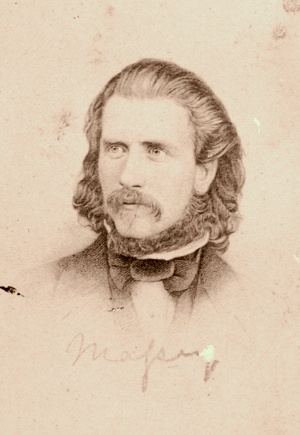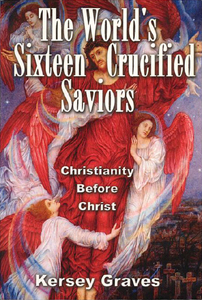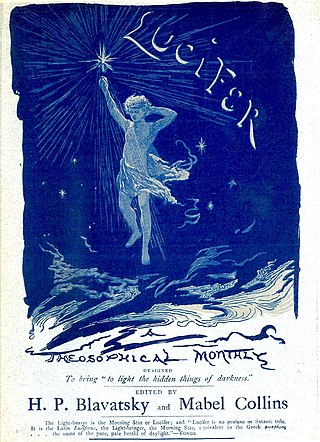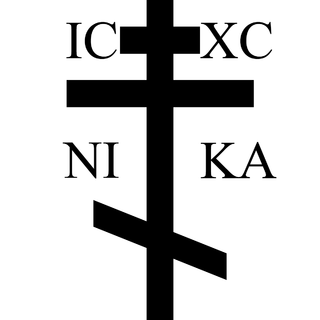Mahātmā is an honorific used in India.

The Great Apostasy is a concept within Christianity to describe a perception that mainstream Christian Churches have fallen away from the original faith founded by Jesus and promulgated through his Twelve Apostles.

A dying-and-rising, death-rebirth, or resurrection deity is a religious motif in which a god or goddess dies and is resurrected. Examples of gods who die and later return to life are most often cited from the religions of the ancient Near East. The traditions influenced by them include the Greco-Roman mythology. The concept of a dying-and-rising god was first proposed in comparative mythology by James Frazer's seminal The Golden Bough (1890). Frazer associated the motif with fertility rites surrounding the yearly cycle of vegetation. Frazer cited the examples of Osiris, Tammuz, Adonis and Attis, Zagreus, Dionysus, and Jesus.
A Bible conspiracy theory is any conspiracy theory that posits that much of what is believed about the Bible is a deception created to suppress a secret or ancient truth. Some such theories claim that Jesus really had a wife and children, or that a group such as the Priory of Sion has secret information about the true descendants of Jesus; some claim that there was a secret movement to censor books that truly belonged in the Bible, etc.

Gerald Massey was an English poet and writer on Spiritualism and Ancient Egypt.
Messianism is the belief in the advent of a messiah who acts as the savior of a group of people. Messianism originated as a Zoroastrian religious belief and followed to Abrahamic religions, but other religions also have messianism-related concepts. Religions with a messiah concept include Hinduism (Kalki) Judaism (Mashiach), Christianity (Christ), Islam, Druze faith, Zoroastrianism (Saoshyant), Buddhism (Maitreya), Taoism, and Bábism.

Thomas William Harpur was a Canadian biblical scholar, columnist, and broadcaster. An ordained Anglican priest, he was a proponent of the Christ myth theory, the idea that Jesus did not exist but is a fictional or mythological figure. He was the author of a number of books, including For Christ's Sake (1986), Life after Death (1996), The Pagan Christ (2004), and Born Again.

The World's Sixteen Crucified Saviors; Or, Christianity Before Christ, Containing New, Startling, and Extraordinary Revelations in Religious History, which Disclose the Oriental Origin of All the Doctrines, Principles, Precepts, and Miracles of the Christian New Testament, and Furnishing a Key for Unlocking Many of Its Sacred Mysteries, Besides Comprising the History of 16 Heathen Crucified Gods is an 1875 non-fiction book written by American freethinker Kersey Graves, which asserts that Jesus was not an actual person, but was a creation largely based on earlier stories of deities or god-men saviours who had been crucified and descended to and ascended from the underworld. Parts were reprinted in The Book Your Church Doesn't Want You to Read edited by Tim C. Leedom in 1994, and it was republished in its entirety in 2001.

The Christ myth theory, also known as the Jesus myth theory, Jesus mythicism, or the Jesus ahistoricity theory, is the view that the story of Jesus is a work of mythology with no historical substance. Alternatively, in terms given by Bart Ehrman paraphrasing Earl Doherty, it is the view that "the historical Jesus did not exist. Or if he did, he had virtually nothing to do with the founding of Christianity."

Godfrey Higgins was an English magistrate and landowner, a prominent advocate for social reform, historian, and antiquarian. He wrote concerning ancient myths. His book Anacalypsis, was published posthumously, in which he asserts a commonality among various religious myths, which he traces back to the supposed lost religion of Atlantis. He has been termed a "political radical, reforming county magistrate and idiosyncratic historian of religions".
Criticism of Christianity has a long history which stretches back to the initial formation of the religion in the Roman Empire. Critics have challenged Christian beliefs and teachings as well as Christian actions, from the Crusades to modern terrorism. The arguments against Christianity include the suppositions that it is a faith of violence, corruption, superstition, polytheism, homophobia, bigotry, pontification, abuses of women's rights and sectarianism.
Criticism of the Bible refers to a variety of criticisms of the Bible, the collection of religious texts held to be sacred by Christianity, Judaism, Samaritanism, and other Abrahamic religions. Criticisms of the Bible often concern the text’s factual accuracy, moral tenability, and supposed inerrancy claimed by biblical literalists. There remain questions of biblical authorship and what material to include in the biblical canon.

Anacalypsis is a lengthy two-volume treatise written by religious historian Godfrey Higgins, and published after his death in 1836. The book was published in two quarto volumes numbering 1,436 pages, and contains meticulous references to hundreds of references. Initially printed as a limited edition of 200 copies, it was partially reprinted in 1878, and completely reprinted in a limited edition of 350 copies in 1927. In 1965, University Books, Inc. published 500 sets for the United States and 500 sets for the British Commonwealth with Publisher's Note and a Postface.

In Christianity, the term biblical authority refers to two complementary ideas:
This is a glossary of terms used in Christianity.
Second Temple Judaism is the Jewish religion as it developed during the Second Temple period, which began with the construction of the Second Temple around 516 BC and ended with the Roman siege of Jerusalem in 70 AD.

The Pagan Christ: Recovering the Lost Light is a 2004 non-fiction book by Canadian writer Tom Harpur (1929–2017), a former Anglican priest, journalist and professor of Greek and New Testament at the University of Toronto, which supports the Christ myth theory. Harpur claims that the New Testament shares a large number of similarities with ancient Egyptian and other pagan religions, that early Church leaders fabricated a literal and human Jesus based on ancient myths and that we should return to an inclusive and universal religion where the spirit of Christ or Christos lives within each of us.

"The Esoteric Character of the Gospels" is an article published in three parts: in November-December 1887, and in February 1888, in the theosophical magazine Lucifer; it was written by Helena Blavatsky. It was included in the 8th volume of the author's Collected Writings. In 1888, for this work, the author was awarded Subba Row medal.

Christianity and Theosophy, for more than a hundred years, have had a "complex and sometimes troubled" relationship. The Christian faith was the native religion of the great majority of Western Theosophists, but many came to Theosophy through a process of opposition to Christianity. According to professor Robert S. Ellwood, "the whole matter has been a divisive issue within Theosophy."











